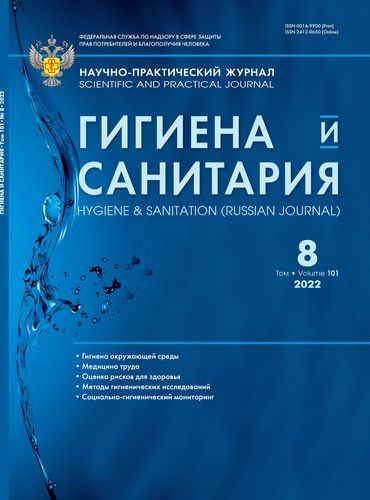Safety assessment of laser projector radiation for the population
- Authors: Malkova N.Y.1,2, Petrova M.D.1
-
Affiliations:
- North-West Public Health Research Center
- North-Western State Medical University named after I.I. Mechnikov
- Issue: Vol 101, No 8 (2022)
- Pages: 850-854
- Section: ENVIRONMENTAL HYGIENE
- Published: 14.09.2022
- URL: https://archivog.com/0016-9900/article/view/638952
- DOI: https://doi.org/10.47470/0016-9900-2022-101-8-850-854
- ID: 638952
Cite item
Full Text
Abstract
Introduction. The target organs of laser radiation include the skin and the organ of vision. The danger of laser beams for the visual analyzer determined the main direction of research in this area, which focused on the study of the damaging effect of radiation on the organ of vision.
The aim of the study is a hygienic assessment of laser radiation from projectors used in cultural events.
Materials and methods. Measurements were carried out on 10 multi-color projectors with capacities from 2 to 30 watts belonging to 2 classes: Kvant and Spectrum and wavelengths of 445–460 nm, 520–532 nm, and 637–640 nm with a tuned projection system at a distance of 7 m from the scanning system.
Results. Analysis of the data obtained showed that, with the exception of the blue spectral region for Kvant 2000 and 3000 projectors, there is an excess of the maximum permissible levels at all wavelengths for all projectors. The greatest exceedances were detected 7–11 times at a wavelength of 532 nm, 8 times at a wavelength of 637 nm.
Limitations. The study was conducted on a limited number of projectors, and the remote control was calculated only for the time of the flashing reflex, which limits the possibilities of a broader interpretation of the data obtained.
Conclusion. The probability of exceeding the maximum permissible levels of laser radiation at the available capacities jeopardizes the safety of the event for both visitors and actors and projector operators. This issue requires a deeper study of protective measures at all levels: both organizational and household.
Compliance with ethical standards. Studies on humans and animals have not been conducted, the study does not require the submission of the opinion of the biomedical ethics committee or other documents.
Contribution:
Malkova N.Yu. — the concept and design of the study, collection and processing of material, statistical processing, writing a text, editing;
Petrova M.D. — collection and processing of material, writing a text.
All authors are responsible for the integrity of all parts of the manuscript and approval of the manuscript final version.
Conflict of interest. The authors declare no conflict of interest.
Acknowledgement. The study had no sponsorship.
Received: May 17, 2022 / Accepted: August 04, 2022 / Published: September 14, 2022
Keywords
About the authors
Natalia Yu. Malkova
North-West Public Health Research Center; North-Western State Medical University named after I.I. Mechnikov
Author for correspondence.
Email: n.malkova@s-znc.ru
ORCID iD: 0000-0002-0426-8851
MD, PhD, DSci., chief researcher of department of complex hygienic assessment of physical factors of North-West Public Health Research Center, St. Petersburg, 191036, Russian Federation.
e-mail: n.malkova@s-znc.ru
Russian FederationMilena D. Petrova
North-West Public Health Research Center
Email: noemail@neicon.ru
ORCID iD: 0000-0001-5506-6523
Russian Federation
References
- Mainster M., Turner P. Retinal injuries from light: mechanisms, hazards, and prevention. Retina. 2005; (2): 1857–70. https://doi.org/10.1016/B978-0-323-02598-0.50115-4
- Kulikov A.N., Vlasenko A.N., Mal’tsev D.S., Kovalenko A.V., Kovalenko I.Yu. Retinal injury from laser pointers: case series. Vestnik Rossiyskoy Voenno-meditsinskoy akademii. 2019; (3): 103–6. (in Russian)
- Zheltov G.I. Standards for laser safety: origins, level, perspectives. Fotonika. 2017; (1): 10–35. https://doi.org/10.22184/1993-7296.2017.61.1.10.35 (in Russian)
- Labin A.M., Safuri S.K., Ribak E.N., Perlman I. Müller cells separate between wavelengths to improve day vision with minimal effect upon night vision. Nat. Commun. 2014; 5: 4319. https://doi.org/10.1038/ncomms5319
- Kaptsov V.A., Deynego V.N. Health risks occurring when color is precepted under led lighting. Analiz riska zdorov’yu. 2017; (2): 16–25. https://doi.org/10.21668/health.risk/2017.2.02 (in Russian)
- Babiyants E.A. The history of the discovery of the mechanism of color vision (the 50th anniversary of the Nobel prize). Zhurnal fundamental’noy meditsiny i biologii. 2017; (1): 56–9. (in Russian)
- Mainster M.A., Sparrow J.R. How much blue light should an IOL transmit? Br. J. Ophthalmol. 2003; 87(12): 1523–9. https://doi.org/10.1136/bjo.87.12.1523
- Ham W.T. Jr., Mueller H.A., Sliney D.H. Retinal sensitivity to damage from short wavelength light. Nature. 1976; 260(5547): 153–5. https://doi.org/10.1038/260153a0
- Mentes J., Erakgun T., Afrashi F., Kerci G. Incidence of cystoids macular edema after uncomplicated phacoemulsification. Ophthalmologica. 2003; 217(6): 408–12. https://doi.org/10.1159/000073070
- Mainster M.A. Intraocular lenses should block UV radiation and violet but not blue light. Arch. Ophthalmol. 2005; 123(4): 550–5. https://doi.org/10.1001/archopht.123.4.550
- Chistyakova N.V., Dal’ N.Yu., Astakhov Yu.S. The influence of light on the state of the retina and health in general: myth or reality? Oftal’mologicheskie vedomosti. 2011; 4(3): 57–64. (in Russian)
- Miroshnichenko A.B., Kroz S.F. On some changes in the functional state of the body during the maintenance of optical quantum generators. Gigiena truda. 1974; (4): 44–5. (in Russian)
- Omelyanenko L.M., Komarova A.A. The state of health of workers with solid-state lasers. In: Clinic and Issues of Examination of Working Capacity in Diseases Caused by Exposure to Physical Factors [Klinika i voprosy ekspertizy trudosposobnosti pri zabolevaniyakh, vyzvannykh vozdeystviem fizicheskikh faktorov]. Moscow; 1971: 99–103. (in Russian)
- Malkova N.Yu. Assessing risk from unfavourable laser radiation effect on visual organ during cultural and public events. Meditsina truda i promyshlennaya ekologiya. 2018; (5): 54–7. https://doi.org/10.31089/1026-9428-2018-5-54-57 (in Russian)
Supplementary files









